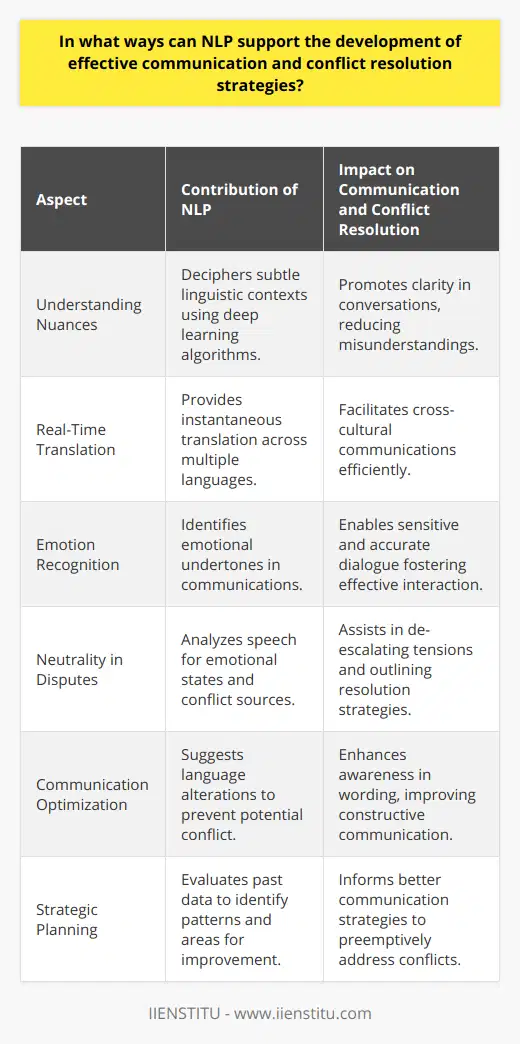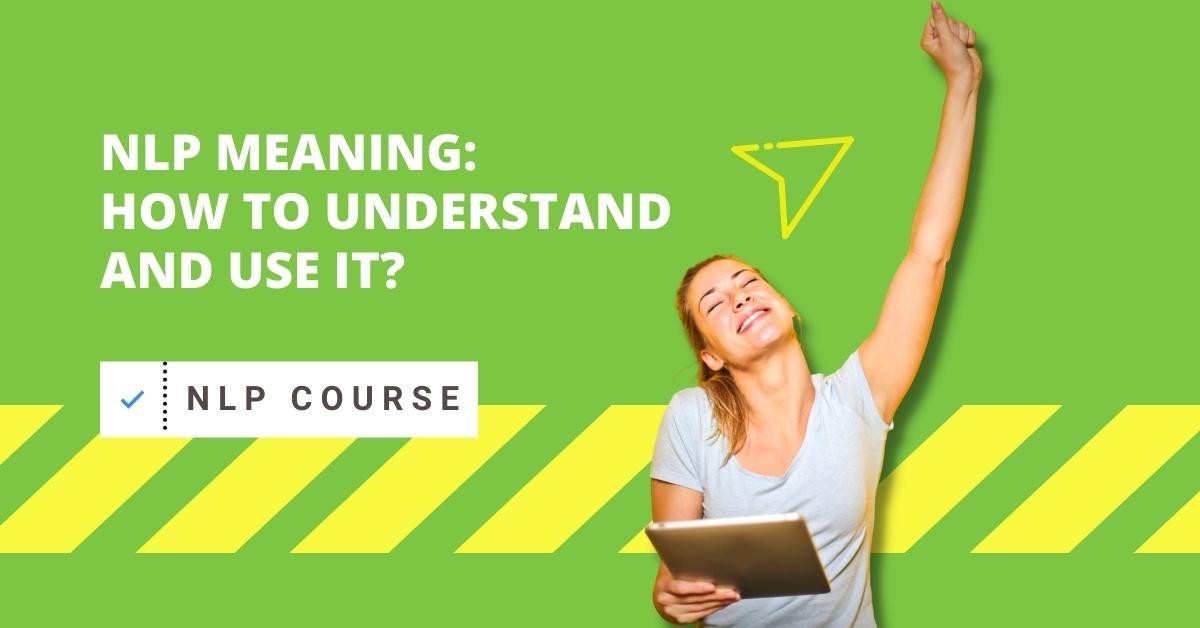
NLP (neuro-linguistic programming) is a robust set of techniques to help you achieve your goals. By understanding how your mind works, you can use NLP to change your thinking and behavior to complete your desired outcomes. In this article, we'll look at how NLP can help you succeed in life. First, we'll discuss the basics of NLP, and we'll explore some helpful tips for using NLP to reach your goals. So let's get started!
What is NLP, and how can it help you achieve your goals
NLP, or Neuro-Linguistic Programming, is psychological programming that focuses on helping individuals achieve their goals. The basic premise of NLP is that our thoughts, emotions, and behaviors are all interconnected. By understanding how these three elements work together, we can more effectively communicate with others and achieve our goals. NLP also teaches us how to identify and change negative thought patterns that may be holding us back. In addition, NLP provides techniques for building self-confidence and developing a positive outlook. By harnessing the power of our thoughts, emotions, and behaviors, NLP can help us achieve our goals and create lasting change in our lives.
The three steps to using NLP for goal setting
If you're interested in using NLP to achieve your goals, there are three basic steps you need to follow. First, you need to define your goals clearly. What do you want to achieve? What are your specific objectives? Once you have a good understanding of your goals, you need to create an action plan. What steps do you need to take to achieve your goals? Finally, you need to take action and follow through with your project. Remember, goal setting is not a one-time event; it's a continuous process that requires ongoing effort and commitment.
How to use the techniques in practice to achieve your goals
Now that we've discussed the basics of NLP and goal setting let's look at how you can put these techniques into practice. Here are some helpful tips:
Get clear on what you want: One of the most critical steps in achieving success is defining your goals. What do you want to achieve? Be as specific as possible. This will help you create a plan of action and stay focused on your goals. Without a clear goal, it can be easy to get sidetracked or discouraged. So take the time to sit down and think about what you want to achieve. Once you have a clear goal in mind, you can start taking steps towards achieving it.
Create a plan of action: A goal without a plan is just a wish. So, if you've been dreamily gazing at that new car or fancy estate you want to buy but have no idea how you're going to afford it, it's time to get serious and create a plan of action. The first step is to take a good hard look at your finances. How much money do you have coming in each month? How much are your essential outgoings - rent/mortgage, utility bills, insurance, etc.? Once you know your starting point, you can look at ways to free up some extra cash each month. Maybe you could switch to a cheaper energy provider or cut back on nights and weekends away. Once you've found some extra money, you can start setting aside money each month to reach your savings goal. It's also good to set up a separate savings account so you're not tempted to spend the money. Finally, keep track of your progress and review your plan regularly to make sure you're still on the way to reaching your goal. Creating a plan of action is the first step to success.
Take action: Once you have set your goals, it is essential to take action and follow through with your plan. This requires commitment and perseverance. Remember, goal setting is not a one-time event; it's a continuous process that requires ongoing effort. To achieve your goals, you need to be willing to work hard and persist even when things get tough. There will be setbacks and obstacles along the way, but if you keep your eye on the prize and remain dedicated to your goals, you will eventually reach your destination. So don't give up – keep moving forward towards your goals, and finally, you will achieve them.
Be patient: Change is never easy. It can be daunting to think about making a significant alteration in your life, whether quitting a bad habit or starting a new one. And it's even harder to stick with it. But it's important to remember that change doesn't happen overnight. Just because you do not see results right away doesn't mean you're not making progress. On the contrary, every step you take, every effort you make, brings you closer to your goal. So don't get discouraged and give up. Instead, be patient and persist with your actions, and eventually, you will see the results you desire.
Get support: Enlist the help of family and friends to support you in your endeavors. In addition, there are many excellent resources available to help you learn more about NLP and goal setting.
Examples of how NLP can be used in different areas of life
NLP can be used in any area of life where you want to achieve a specific goal. Here are just a few examples:
Career: If you're looking to boost your career, there's no better way to do it than learning NLP. Neuro-linguistic programming is a set of tools and techniques that can help you communicate more effectively, achieve your goals, and get the most out of your relationships. So whether you're looking to land your dream job, advance in your career, or start your own business, NLP can give you the edge you need to succeed. Channels. As a result, a well-tended lawn can play an essential role in preventing soil erosion.
Learn the skills to achieve your goals and dreams
Communicate more effectively with others
Achieve more tremendous success in your career or business
Master the art of persuasion and influence
2. Relationships: NLP, or neuro-linguistic programming, is a process that can be used to improve communication and build stronger relationships. NLP's techniques can help you resolve conflict, understand other people's points of view, and communicate more effectively. By learning how to use NLP, you can improve your personal and professional relationships. The process can also help you achieve your goals and overcome obstacles. If you want to improve your communication skills, build stronger relationships, and resolve conflict, then NLP could be the answer you're looking for.
Learn how to communicate effectively with anyone
Resolve conflicts in a more constructive way
Understand other people's points of view better
Achieve your goals more efficiently and overcome obstacles
3. Education: As a student, you are always looking for ways to study more effectively and improve your grades. Wouldn't it be great if there was a way to learn that was more effective and efficient? Neuro-linguistic programming (NLP) is a set of tools and techniques to help you achieve your educational goals. NLP can help you overcome procrastination, develop better study habits, improve your memory, and boost confidence. With NLP, you will be able to learn more in less time and achieve the success you've always wanted.
Improve grades and study more effectively
Overcome procrastination and develop better study habits
Boost confidence and achieve success
Learn more in less time
4. Health and fitness: If you're looking to make some healthy lifestyle changes, lose weight, or get in shape, you may consider using NLP. NLP, or neuro-linguistic programming, is a technique that can help you change your thoughts and behaviors to achieve your desired results. By understanding how your mind works and the language you use to talk to yourself, you can learn to make positive changes to help you reach your goals. You can use NLP to overcome obstacles and create new habits that will lead to a healthier, happier life. If you're ready to make some positive changes, NLP may be just what you need.
Change your thoughts and behaviors to achieve your goals
Understand how your mind works and the language you use to talk to yourself
Overcome obstacles and create new habits for a healthier life
Achieve success in any area of life, including health, fitness, relationships, business, or finance
5. Personal development: If you're looking to boost your self-confidence or overcome fears and phobias, you may want to consider trying NLP or Neuro-Linguistic Programming. NLP is a type of therapy that focuses on helping people change their thoughts and behaviors to achieve their goals. While it is often used to treat anxiety and depression, it can also help people overcome fears and phobias, boost their self-confidence, and achieve their personal goals. NLP is particularly effective in treating phobias, as it can help people break down their fear into manageable parts and then work through each part systematically. If you're interested in trying NLP, find a qualified therapist who has experience treating the specific issue you're looking to address.
Improve your self-confidence and overcome fears and phobias with NLP
Achieve your personal goals with the help of NLP
Effectively treat phobias with NLP
The benefits of using NLP for goal setting
NLP is a potent tool that can help you achieve your goals. When used correctly, NLP can help you:
Define your goals more clearly
Create a plan of action
Take action and persist with your efforts
Be patient and get support when needed
Achieve your goals in any area of life
In conclusion, NLP is a powerful tool to help you achieve your goals. The three steps to using NLP for goal setting are simple and easy to follow, and with practice, you can use these techniques to achieve anything you want in life. Whether you're looking to improve your health, wealth, or relationships, NLP can help get you there. And the benefits of using NLP for goal setting are numerous – from improved focus and motivation to faster achievement of goals and increased happiness once they're reached. If you're ready to start achieving your dreams, sign up for our upcoming NLP course today!
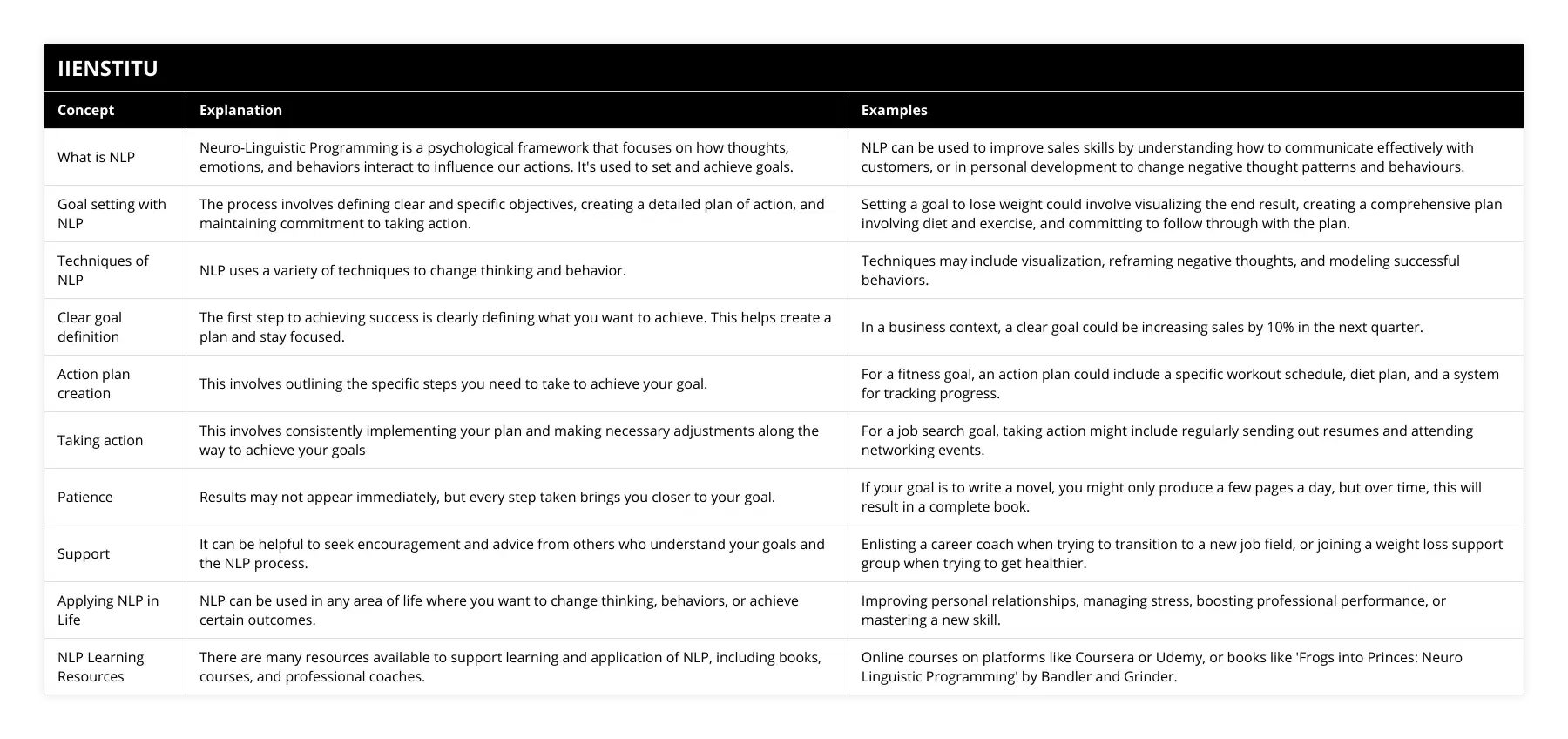
Frequently Asked Questions
What is NLP?
NLP is an acronym for Neuro-Linguistic Programming. NLP is a type of psychological therapy that helps individuals achieve their goals by changing their thoughts, emotions, and behaviors.
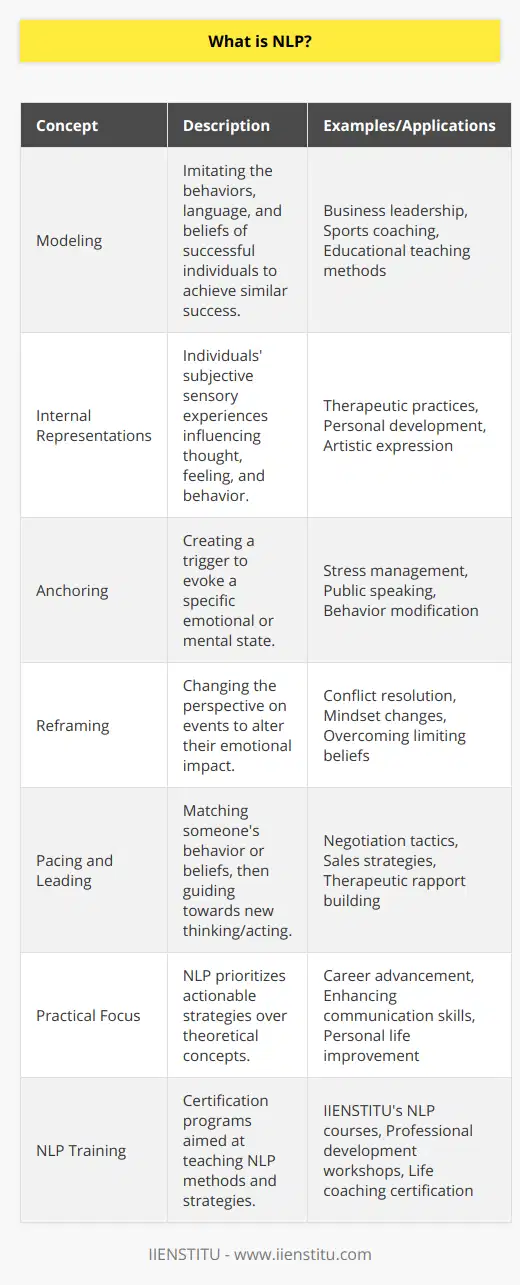
How can NLP help me achieve my goals?
By understanding how our thoughts, emotions, and behaviors are interconnected, we can more effectively communicate with others and make positive changes in our lives. NLP can help you overcome obstacles, achieve your goals, and improve overall well-being.
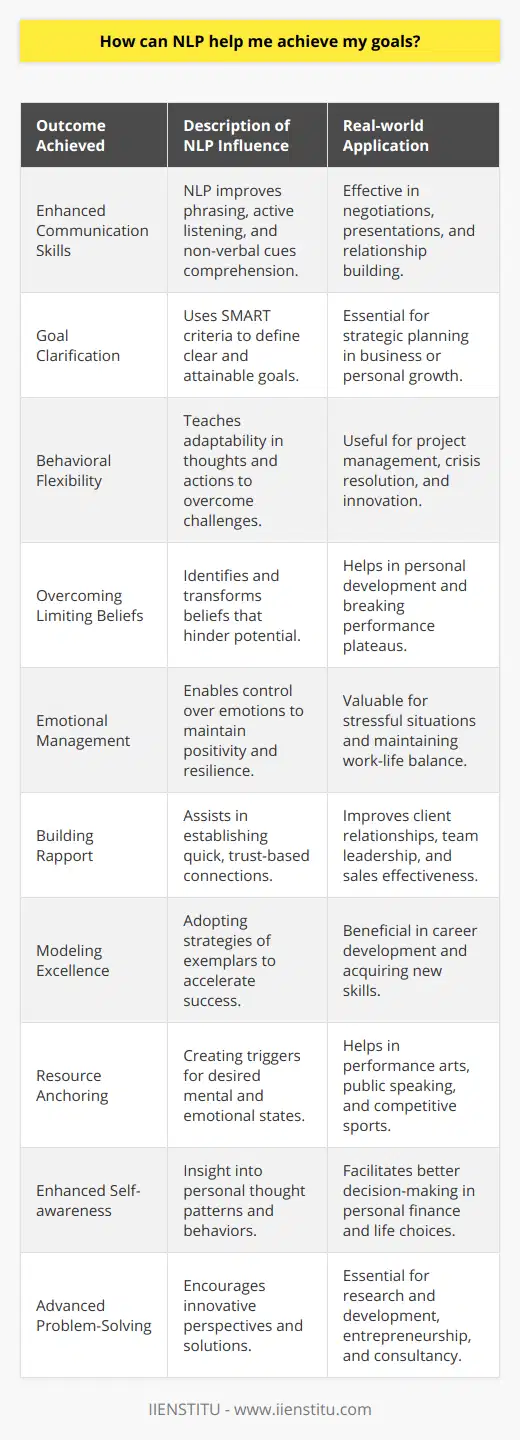
What are the three steps to using NLP for goal setting?
The three steps to using NLP for goal setting are: 1) clearly defining your goals; 2) creating a plan of action, and 3) taking action and following through with your plan.
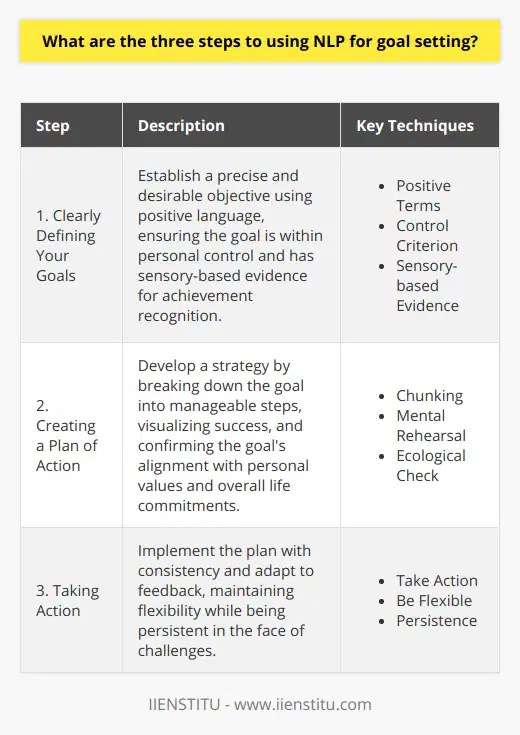
How to use NLP for success?
Methods of Applying NLP for Success
Understanding the Basics
To use neuro-linguistic programming (NLP) effectively for success, it is important to grasp its fundamental principles. NLP involves the study of human behavior patterns, language, and thinking processes to improve communication, self-awareness, and personal growth. By learning the techniques and tools within NLP, individuals can develop specific skills to advance in their personal and professional lives.
Establishing Rapport
One crucial aspect of NLP is the ability to build rapport, which refers to establishing a connection and creating trust with others. Rapport can be achieved through matching verbal and non-verbal communication, including body language, voice tone, and language patterns. By developing strong rapport skills, one can successfully influence and persuade others, enhancing interpersonal relationships and negotiations for personal and professional success.
Setting SMART Goals
NLP encourages the use of specific, measurable, achievable, realistic, and timely (SMART) goals to facilitate success. By setting SMART goals, individuals can evaluate their progress and focus on quantifiable outcomes. This approach aligns personal values and aspirations with achievable objectives and fosters a sense of accomplishment and motivation.
Reframing Limiting Beliefs
Limiting beliefs often hinder personal and professional growth, leading to self-imposed obstacles and lack of success. Using NLP techniques, one can identify and reframe these limiting beliefs by adopting a new mindset and establishing empowering beliefs. This transformative process not only improves self-esteem but also enables individuals to achieve success by overcoming mental barriers.
Practicing Visualization
Visualization, an essential component of NLP, involves mentally rehearsing specific situations or desired outcomes to enhance performance and achieve success. This technique helps create a clear mental image of the desired result and enables an individual to feel more motivated and prepared for a given task. This practice aids in bridging the gap between where an individual is currently and where they want to be.
Utilizing Anchoring Techniques
NLP anchoring techniques serve as valuable tools for success, as they enable individuals to elicit desired emotional states in themselves and others. Anchoring helps associate a particular stimulus with a specific response, which can be recalled at will. This technique assists in managing emotions, increasing confidence and resourcefulness, and developing positive habits, all of which contribute significantly to achieving success.
In conclusion, leveraging NLP techniques such as establishing rapport, setting SMART goals, reframing limiting beliefs, practicing visualization, and utilizing anchoring can significantly contribute to personal and professional success. By developing a deeper understanding of NLP principles, individuals can enhance their communication, self-awareness, and goal-setting abilities, ultimately leading to a more successful and fulfilling life.
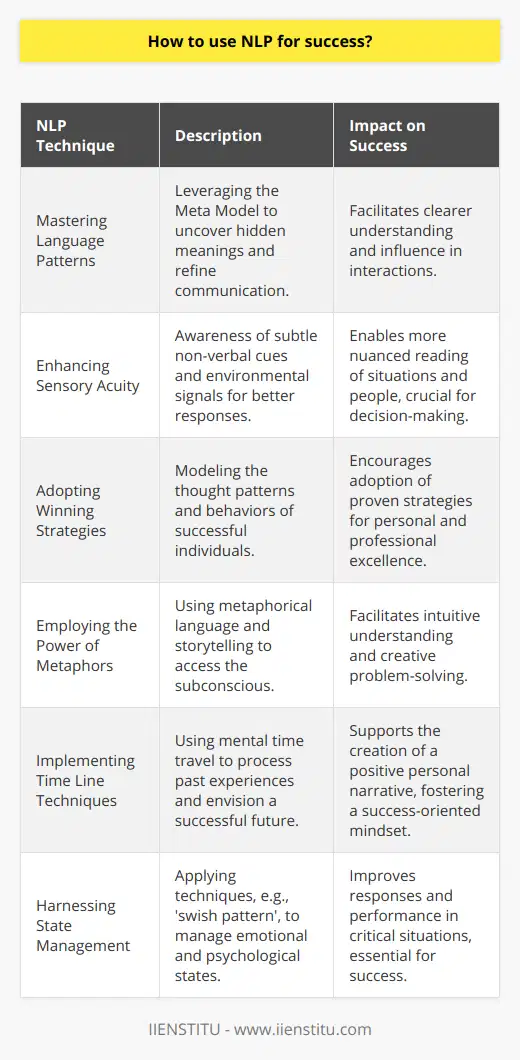
What is an example of a goal in NLP?
Example of a Goal in NLP
Understanding Language Models
An example of a goal in natural language processing (NLP) is the development of language models. Language models aim to enable machines to understand, interpret, and generate human language effectively.
Role of Probabilities
Probabilities play a crucial role in this goal. For instance, language models measure probabilities of word sequences to predict the likelihood of specific phrases or sentences occurring in real-world communication.
N-Gram Language Model
One fundamental language model is the n-gram model. This model breaks text into consecutive groups of n elements to predict the probability of the next word in a sentence based on previously encountered words.
The Neural Network Approach
Recently, researchers have focused on neural network-based language models. These models use deep learning techniques to better capture context and generate more coherent and fluent language.
The Transformer Model
A crucial breakthrough in neural network-based language models is the transformer model. This architecture introduces self-attention mechanisms and replaces the need for recurrent layers, significantly improving NLP tasks.
Recent Developments
GPT-3 (Generative Pre-trained Transformer) is an example of a state-of-the-art language model that can generate coherent and contextually relevant text. This model has broadened the horizons for developing more advanced algorithms in NLP.
Challenges and Limitations
Despite the advancements, language models still face challenges and limitations. These include difficulties in understanding ambiguous phrases, detecting sarcasm or irony, and accounting for different language nuances and dialects.
In Summary
Achieving mastery in language models is a significant goal in NLP. It involves understanding the role of probabilities, employing n-gram and neural network-based models, and addressing current limitations to produce coherent and contextually relevant text.
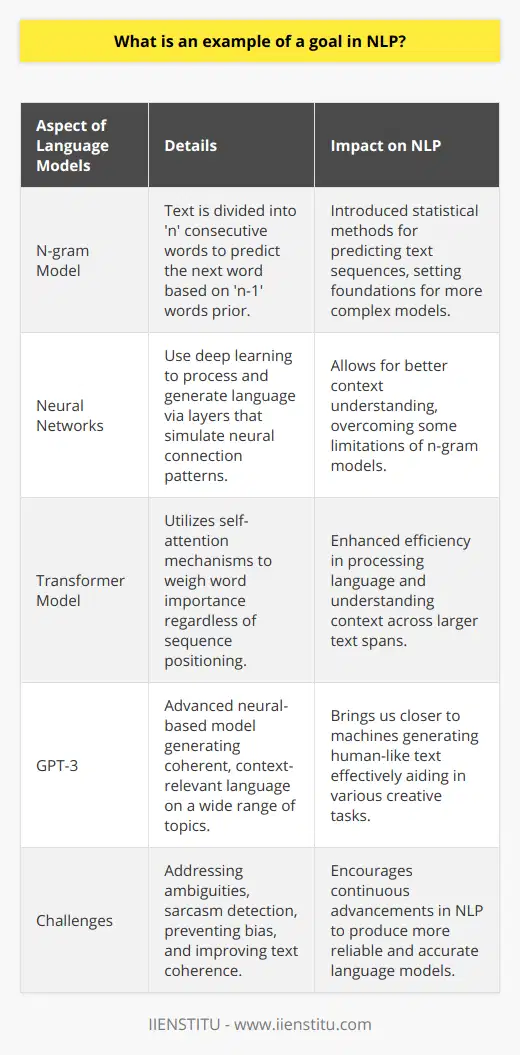
How would you use NLP to personally improve your own life?
**Applying NLP for Self-Improvement**
The utilization of natural language processing (NLP) can significantly enhance one's life through various personal improvements. NLP, as a subfield of artificial intelligence that specializes in processing human language, holds great potential for self-improvement in areas such as communication, time management, and learning.
**Enhancing Communication Skills**
Firstly, NLP can help bolster interpersonal communication. Analyzing text messages, emails, or social media posts with NLP tools can reveal patterns and insights on improving writing clarity, tone, and effectiveness. Sentiment analysis, a popular NLP technique, can assist in understanding emotions conveyed in written communication, ensuring that the intended message aligns with the perceived tone.
**Streamlining Time Management**
Using NLP for time management may facilitate a more organized and efficient daily routine. Smart virtual assistants equipped with NLP can convert spoken words into scheduled events, reminders, or notes. This enables a hands-free and more punctual approach toward managing commitments.
**Facilitating Language Learning**
NLP can help expedite foreign language acquisition. Language learning applications that leverage NLP can provide timely feedback on grammar, pronunciation, and vocabulary usage, accelerating the learning process. Additionally, the customization of learning materials aligns with individual needs and preferences, making language learning more engaging and efficient.
**Empowering Self-Evaluation**
Lastly, NLP can serve as a tool for self-evaluation and growth by enabling the analysis of one's own language in various contexts. For example, by using NLP to process our self-talk or journal entries, we may identify recurring patterns or themes that influence our thought processes and behaviors. This awareness can lead to more effective goal-setting and decision-making.
In conclusion, employing NLP in everyday life promises substantial personal improvement by enhancing communication skills, streamlining time management, facilitating language learning, and empowering self-evaluation. The accessibility of NLP technology allows individuals to leverage its potential for continuous growth, optimization, and overall life advancement.
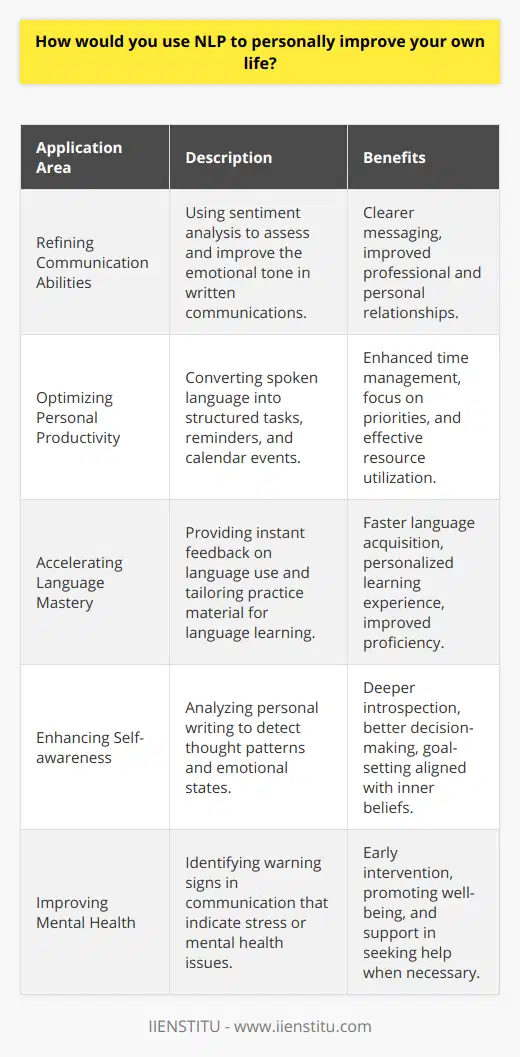
What are the underlying principles of NLP and how do they contribute to achieving success?
Understanding the Principles of NLP
NLP or Neuro-Linguistic Programming has its genesis in the connection between neurological processes, language, and behavioral patterns learned through experience. Understanding these principles can facilitate personal and professional success.
The Base of NLP
A fundamental principle of NLP is that the mind and body interact. This belief underscores the reciprocal relationship between our physical state and mental well-being. By controlling one, we can consequently regulate the other.
Subjectivity of Perceptions
Another NLP principle asserts that everyone experiences the world differently due to their unique interpretations. Recognizing this subjectivity allows us to understand our perceptions better and adjust them to improve our experiences.
Modeling Excellence
NLP also emphasizes modeling successful behaviors. It suggests that by emulating the traits of successful individuals, people can integrate these effective behaviors into their practices, enhancing their own success.
Active Role of Language
Lastly, NLP gives high importance to the language we use. It suggests that our language does not merely describe our reality, but also creates it.
Achieving Success Through NLP
Understanding these principles empowers us to achieve success. Seeing the mind and body as interconnected helps us focus on maintaining a balance between physical health and mental wellbeing, enhancing overall productivity.
Recognizing the subjectivity of experiences allows us to handle situations better and foster better relationships, paving the way for success in personal and professional arenas. Copying successful behaviors ensures that we follow tried and tested strategies, increasing our success chances.
Finally, being aware that our language has the power to create our experiences helps us shape our reality. By consciously using positive language, we can create an optimistic mindset, fostering a positive attitude that is often key to success.
In conclusion, the principles of NLP inform us about the interconnectedness of mind and body, the subjectivity of perceptions, the importance of mimicking successful behaviors and the active role of language. Comprehending and applying these principles can lead to more productive, successful lives.
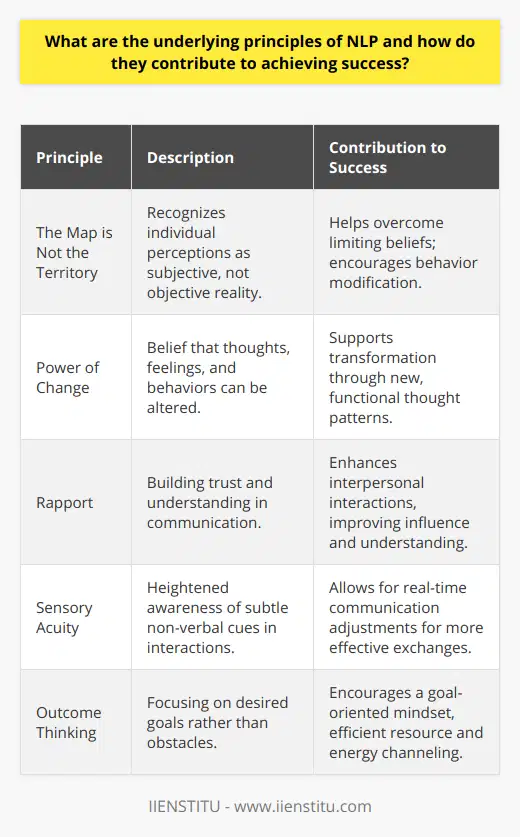
How can one effectively apply NLP techniques for enhancing motivation and maintaining focus?
Utilizing NLP for Enhanced Motivation
NLP or Neuro-Linguistic Programming can substantially improve motivation by changing an individual’s cognitive and behavior patterns. A simple NLP technique is ‘anchoring’, which associates positive emotional states with certain stimuli leading to conditioned motivation.
Applying Anchoring
This technique works by choosing a physical action, like tapping a desk, and pairing it with a desired emotional state, such as feeling motivated. Repeating this act consistently will ultimately build a conditioned response, invoking motivation when performing the action.
NLP for Enhanced Focus
NLP can also aid in maintaining focus. ‘Swish Pattern’ is a technique used to replace a non-desired state of mind with a desired one. It requires envisioning a clear image of a distracted state, then ‘swishing’ it away and replacing it with an image that represents a focused state.
Applying Swish Pattern
For instance, one could visualize a blurry, cluttered desktop portraying distraction and replace it with a clear, organized workspace to represent focus. Regular practice facilitates automatic transition from distraction to focus upon encountering similar situations.
Combining NLP Techniques
For maximum efficacy, one should combine anchoring and Swish Pattern. Encountering a distracting situation triggers the Swish Pattern, which shifts the state to focus, followed by the use of anchoring to enhance motivation.
Consistent Practice
Regular and conscious practice of these techniques is paramount for their effectiveness. One must persist in practicing, tweaking, and fine-tuning these methods to suit their unique mental constructs.
Hence, NLP techniques, when applied correctly and consistently, can profoundly alter cognitive and emotional states, thereby enhancing motivation and maintaining focus. These techniques offer the potential for improved productivity and overall individual performance.
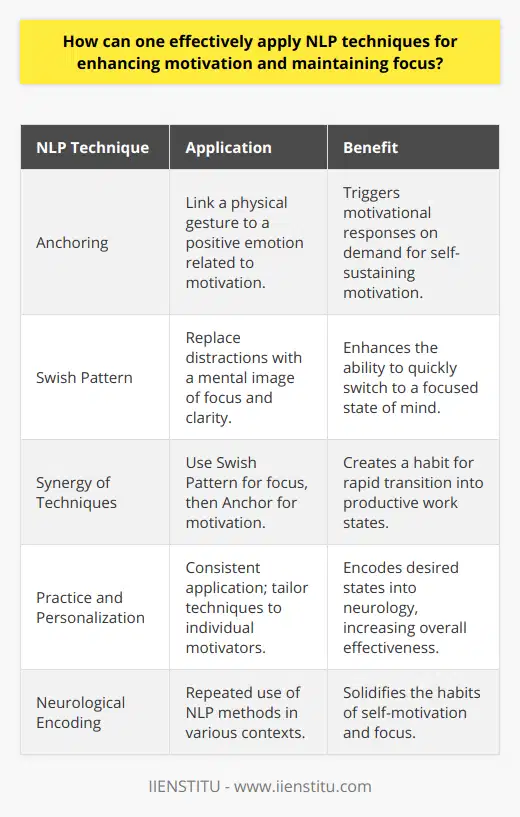
Which NLP exercises are particularly useful for improving communication skills and personal growth?
Useful NLP Exercises
NLP, or Neuro-Linguistic Programming, includes several useful exercises that could improve communication and encourage personal growth.
Anchoring Technique
The anchoring technique, for instance, trains individuals to associate positive mental states with certain actions or words. This exercise results in enhanced self-confidence which can significantly improve interpersonal communication skills.
Representational Systems Exercise
Representational systems exercise, on the other hand, involves identifying an individual's preferred sensory language - visual, auditory, or kinesthetic. By understanding your own or others' dominant sensory language, communication becomes more effective.
Perceptual Positions
Another beneficial NLP exercise is the Perceptual Positions. This method encourages individuals to perceive situations from different viewpoints, fostering empathy and understanding. Improved empathy can often lead to better communication.
Meta Model
The Meta Model exercise aims at refining language patterns. This helps in achieving clarity in communication, consequently averting possible misunderstandings.
Swish Pattern
The Swish Pattern is another effective NLP method. This exercise involves swapping a negative thought or emotion with a positive one, thereby promoting personal growth.
Mirroring and Matching
Lastly, Mirroring and Matching is a technique used in NLP to establish rapport and trust, two crucial elements in effective communication. This strategy involves matching language, tone, body language, and even breathing patterns with the person you are communicating with, signaling that you are on the same wavelength.
In conclusion, NLP exercises offer substantial benefits for communication skills and personal growth. They not only enrich interpersonal interactions but also foster self-understanding and empathy, vital for personal development.
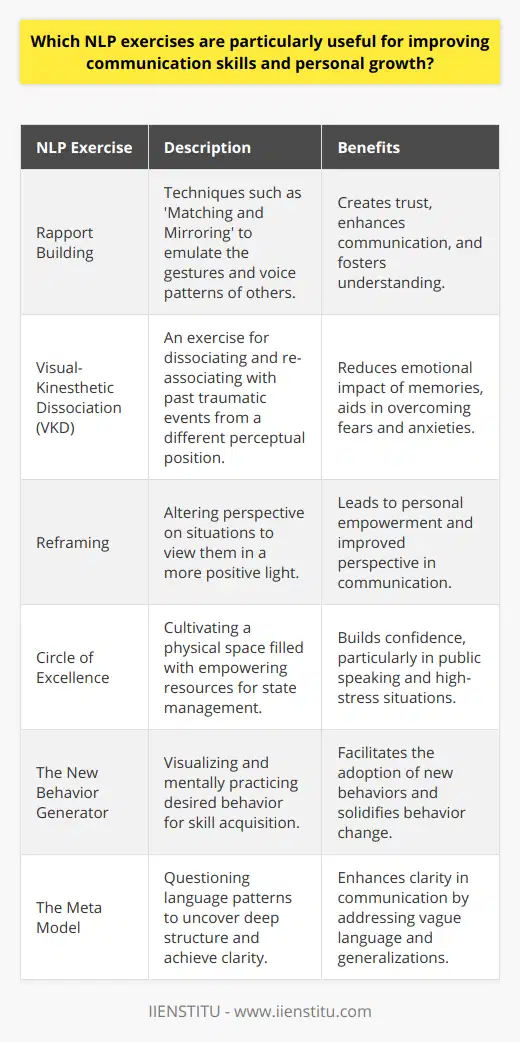
How can NLP contribute to developing problem-solving skills and resilience in challenging situations?
Leveraging NLP for Problem-solving Skills
Neuro-Linguistic Programming (NLP) can augment problem-solving skills by enhancing our cognitive abilities. It harmonizes our perceptual, cognitive, and behavioral actions, helping us manage complex situations more effectively. NLP strategies including reframing, leveraging anchors, and state management can shift our mental perception of issues, refocus our responses, and facilitate better decision-making processes.
Role of NLP in Enhancing Resilience
By enabling cognitive restructuring, NLP can push individuals to approach challenging situations with optimism and resilience. Asymptomatic techniques in NLP can help individuals identify and reprogram subconscious patterns that breed negativity. This encourages resilience by exploring alternative problem-solving routes and leading to more positive outcomes.
Integrating NLP during Challenging Situations
Captivatingly, NLP's assistance extends to particularly challenging scenarios. By employing techniques like 'perceptual positions', it encourages individuals to view situations from various perspectives. This allows for a more well-rounded understanding of the challenge, promoting a more constructive, solution-focused mindset.
Boosting Emotional Intelligence with NLP
NLP further helps in developing emotional intelligence, an essential ingredient for success in problem-solving and resilience. This approach emphasizes understanding, managing and using emotions in a beneficial way. As a vital part of resilience, emotional intelligence can help navigate through challenges, bounce back from setbacks, and adapt to changing circumstances.
In conclusion, NLP can significantly contribute to the development of resilience and problem-solving skills in challenging situations. Its techniques prepare the mind to handle challenges with positivity and reach assertive decisions, fostering a sustainable change in an individual's attitude and approach towards difficulties. Through these skills, individuals can better navigate through life’s adversities and come out stronger.
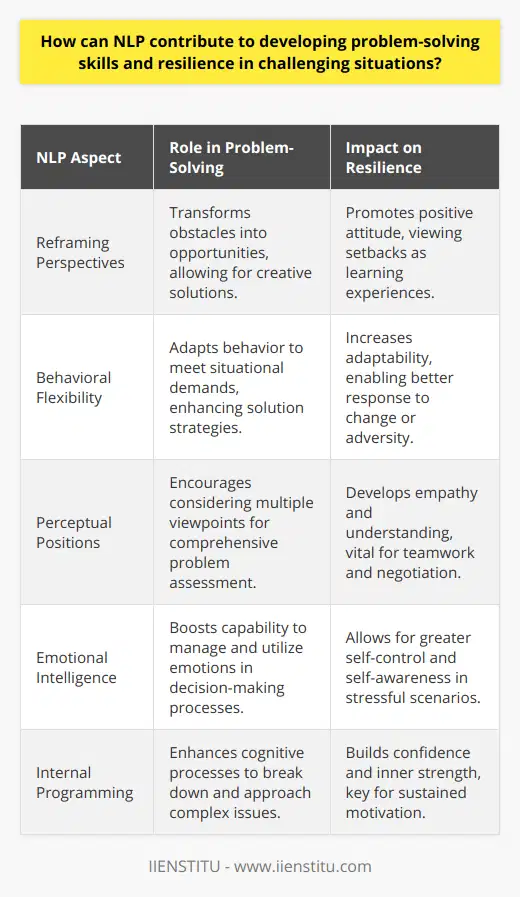
What is the role of NLP in fostering emotional intelligence and self-awareness?
Understanding NLP
Natural Language Processing (NLP) plays a crucial role in fostering emotional intelligence and self-awareness. A subfield of artificial intelligence and linguistics, NLP deals with interactions between computers and human language. It is about programming computers to process large amounts of natural language data. NLP algorithms enable computers to understand, interpret, and replicate human language in a naturally intelligent manner.
Role in Emotional Intelligence
NLP aids tremendously in promoting emotional intelligence. It assists the user in identifying and managing emotions, sharpening their capacity to empathize with others. Sentiment analysis - a common NLP task, assesses the mood or subjective opinion within large amounts of text. This helps individuals recognize and understand emotions in context. Through this, they can better interpret emotional cues, improving interpersonal communication.
Improving Self-Awareness
NLP can also heighten self-awareness. It helps individuals understand their own thoughts, feelings and behaviors better. This is done through language processing techniques that identify patterns, biases and emotional states in the user's verbal and written expressions. Recognizing these patterns can expose unconscious biases, creating an opportunity for personal growth. Consequently, individuals can make conscious efforts to alter their behavior and improve their responses to different situations.
In conclusion, NLP has significant importance in enhancing emotional intelligence and self-awareness. Through language and sentiment analysis, it aids in identifying and managing emotions thereby fostering emotional IQ. Meanwhile, it supports the process of self-awareness by revealing unconscious linguistic patterns and biases. Hence, NLP functions as a useful tool for personal improvement in these two key areas.
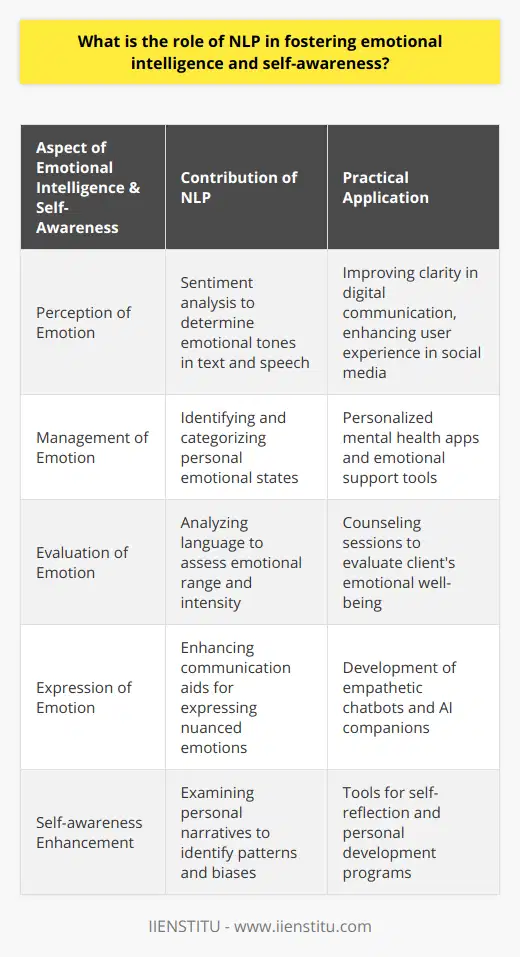
Can NLP be effectively integrated into leadership and management strategies for enhanced performance and decision-making?
Integrating NLP into Leadership and Management
Natural Language Processing (NLP) can be effectively integrated into leadership and management strategies for enhanced performance and decision-making. It can bring a strong value proposition.
Understanding Employee Sentiments
A critical aspect of leadership is understanding employee sentiments. NLP can analyze textual data from employee feedback or social media posts. It enhances leaders' understanding and aids them in making informed decisions for employee satisfaction.
Improving Internal Communication
NLP can streamline internal communication. It can transcribe and translate verbal communications, aiding in overcoming language barriers. The availability of these tools aids managers in ensuring the clarity and efficiency of the communication process.
Enhancing Decision Making
NLP can aid in data-driven decision-making. By analyzing vast volumes of textual data, NLP can extract valuable insights. These insights can guide managers towards strategic, fact-based decisions which might ultimately enhance company performance.
Optimized Knowledge Management
NLP can be a significant factor in optimizing knowledge management. Processing a large amount of unstructured data, including emails, reports, and other data sources, creates a pool of knowledge. This can equip leaders with further insights for strategic actions.
In conclusion, NLP holds great potential for leadership and management strategies. Through sentiment analysis, improving communication, aiding decision-making, and optimizing knowledge management, it supports better decision-making processes and leads to enhanced performance.
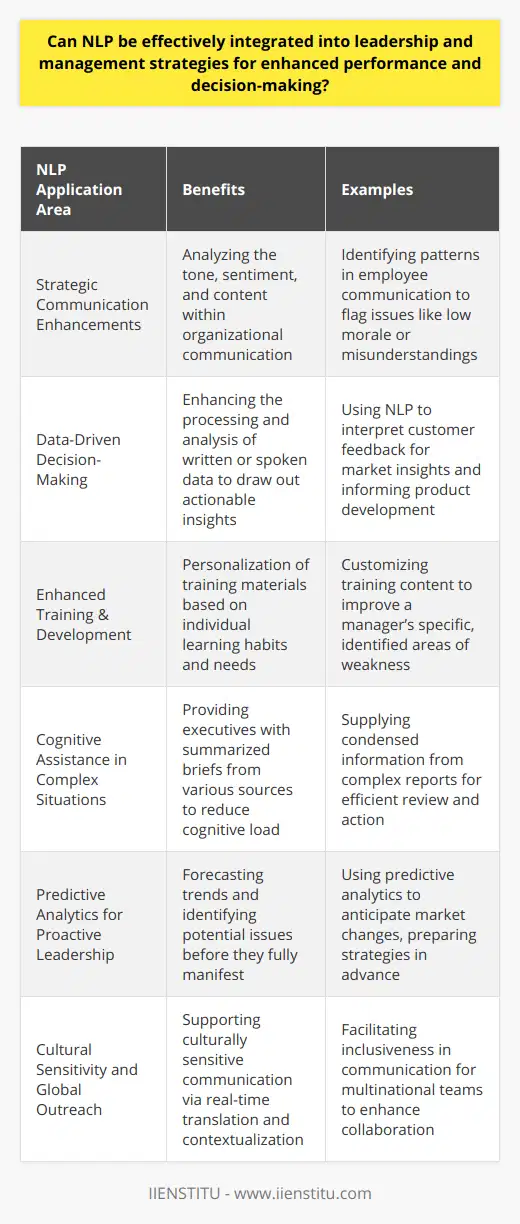
How do you use NLP for goal setting?
Utilizing NLP in Goal Setting
Natural Language Processing (NLP) has emerged as a vital tool in goal setting. It facilitates better understanding and refining of goals. NLP essentially involves the use of machine learning and AI to analyze human language.
Role of NLP
In goal setting, the foremost use of NLP is understanding what the goal entails. For instance, it can analyze a broad goal statement and identify key components. The extracted elements can provide specifics, shaping a clear, tangible goal.
NLP for Objectivity
Naturally, goal statements can be ambiguous or subjective. NLP provides a framework to refine these into clear, objective, and achievable goals. It analyzes language, identifies ambiguities, and helps reformulate for clarity.
Converting Language into Data
Further, NLP can convert language into data. This data provides measurable indicators of progress towards achieving a goal. For example, in weight loss, NLP can translate a general goal, 'lose weight’, into measurable data points such as 'lose 10 pounds in 2 months'.
NLP and SMART Goals
Moreover, NLP aids in creating SMART (Specific, Measurable, Achievable, Relevant, and Time-bound) goals. The analysis of language can precisely determine each attribute of a SMART goal. This results in targeted effort and effective progress tracking.
Interpretation of Feedback
Finally, NLP plays a crucial role in feedback interpretation. It can process feedback obtained during the pursuit of a goal. This helps in reassessing and adjusting goals as needed.
In conclusion, NLP can bring structure, clarity, and objectivity to goal setting. The machine learning feature ensures adaptability and refinement—the key ingredients for a successful goal-setting process.
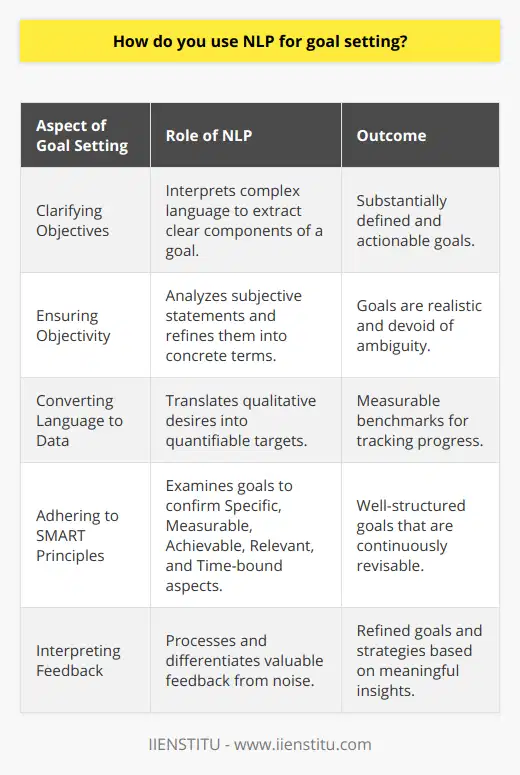
What techniques does NLP use to facilitate personal and professional growth?
Techniques for Personal Growth in NLP
Neuro-Linguistic Programming (NLP) uses several techniques to facilitate personal growth. One core technique is Anchoring, which links sensory experiences to mental states. By pairing positive stimuli with desired states of mind, individuals can recreate these states at will. This technique helps in building resilience, managing stress, and enhancing personal performance.
Reframing Patterns in NLP
Reframing is another NLP technique that promotes behavioral change. It involves changing one's perspective on a situation to create a different emotional response. This shift in perspective helps combat limiting beliefs and overcome negative thought patterns.
The Swish Pattern Technique
The Swish pattern technique is another effective method. This approach changes an unwanted behavior or state into a desirable one. It is a powerful tool for personal transformation and encourages a positive change in behavior.
Methods for Professional Growth in NLP
In professional growth, NLP employs techniques such as the Logical Levels model. This method helps individuals understand their identity, beliefs, capabilities, behaviors, and environment. By comprehending these distinct levels, one can successfully manage career goals and improve their professional journey.
The Meta-Model Technique
The Meta-Model technique aids in improving communication skills. It investigates hidden assumptions, generalizations, and deletions in language to foster clarity in conversations. This model enhances professional relationships by promoting authentic communication.
In conclusion, NLP techniques offer a significant contribution to personal and professional growth. They promote positive behavioral change, enhance communication skills, and encourage a better understanding of one's identity and environment. Consequently, these tools facilitate a well-rounded growth trajectory in both personal and professional spheres.
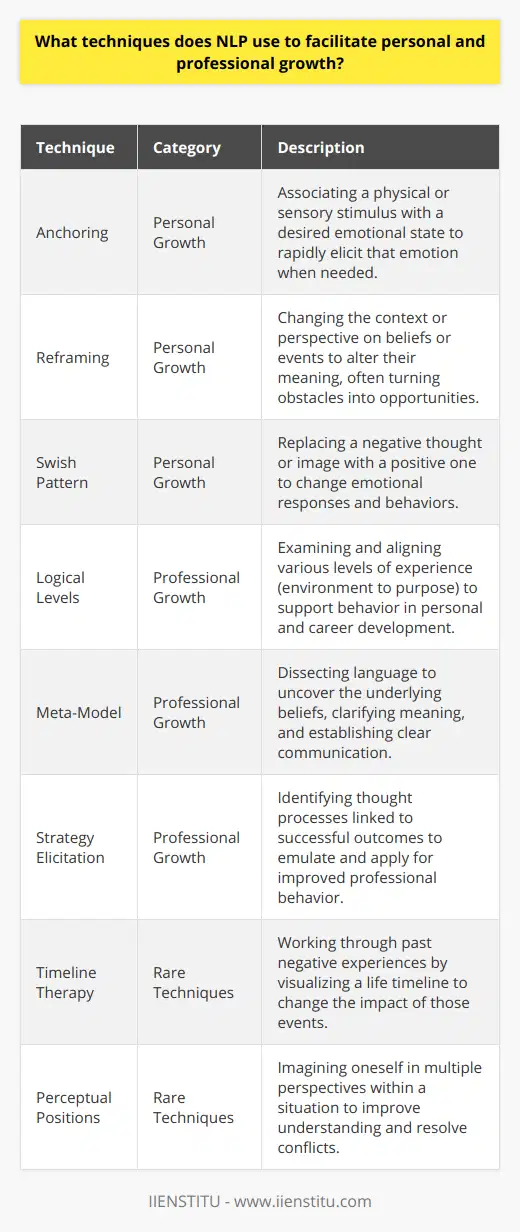
In what ways can NLP support the development of effective communication and conflict resolution strategies?
The Role of Natural Language Processing (NLP)
NLP can greatly contribute to enhancing conversational intelligence. It aids in interpreting human language, allowing for better understanding and accuracy in response. This effectively aids in fostering smoother and less erroneous communication.
NLP and Effective Communication
NLP, through machine learning and AI, can understand, translate, and generate human language effectively. It helps extract important information, comprehend emotions, and even predict user behaviour. By doing so, it simplifies and enriches the communication process. Moreover, NLP can tailor responses based on the user's sentiment, promoting a more empathetic and effective exchange of information.
Easing Conflict Resolution with NLP
As an automated mediator, NLP can help in conflict resolution. By understanding the semantics of the conflict, NLP can identify pain points, trigger words, or aggressive tones. This allows for the nudging of individuals towards less contentious language use or offering insights on finding common ground. Participants can then align understanding, clarify misconceptions, and settle disagreements more effectively.
NLP's Contribution to Strategy Development
The understanding, analysis, and prediction capabilities of NLP lead to a more informed strategy development. It offers valuable insights on communication patterns, trends, and impacts. With this data, strategies for communication and conflict resolution can become more targeted, predictive and adaptive, leading to more favourable outcomes.
In conclusion, the rise of NLP opens avenues for optimized communication and conflict resolution strategies. Its capabilities not only enhance understanding and clarity in communications, but also provide supportive data for more effective strategy development in these realms. This makes essential stride towards better human relations and interaction.
